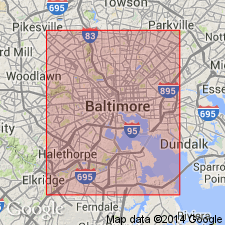
- Usage in publication:
-
- Cockeysville marble*
- Modifications:
-
- Original reference
- Dominant lithology:
-
- Marble
- AAPG geologic province:
-
- Piedmont-Blue Ridge province
Summary:
(USGS map of Baltimore and vicinity, to accompany "Guide to Baltimore," prepared for Baltimore meeting Amer. Inst. Mining Engineers Feb. 1892). Cockeysville marble. Highly crystalline dolomite with all its original impurities separated in form of well-defined minerals. Extensively quarried at Cockeysville, Maryland. Overlies Setters quartz schist and underlies gneiss [Wissahickon formation]. Age is pre-Cambrian.
Source: US geologic names lexicon (USGS Bull. 896, p. 478-479).

- Usage in publication:
-
- Cockeysville marble
- Modifications:
-
- Overview
- AAPG geologic province:
-
- Piedmont-Blue Ridge province
Summary:
Thickness of the Cockeysville ranges from 0 to 2,000 ft. [In a 1909 publication, Maryland Geological Survey, v. 8, author gives thickness as 2,300 ft.]
Source: GNU records (USGS DDS-6; Reston GNULEX).
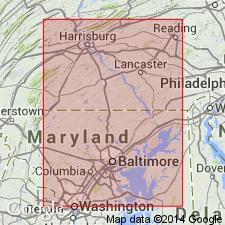
- Usage in publication:
-
- Cockeysville marble*
- Modifications:
-
- Revised
- AAPG geologic province:
-
- Piedmont-Blue Ridge province
Summary:
Cockeysville included in Glenarm series. Underlies Wissahickon formation and overlaps Setters formation. Thickness given as 400+/-ft. Age is Algonkian [Precambrian].
Source: GNU records (USGS DDS-6; Reston GNULEX).
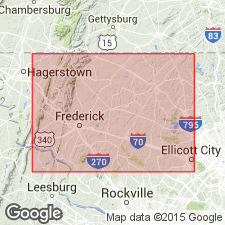
- Usage in publication:
-
- Cockeysville marble*
- Modifications:
-
- Revised
- Areal extent
- AAPG geologic province:
-
- Piedmont-Blue Ridge province
Summary:
On the geologic map of Carroll Co. (1928), all marble and limestone exposed in crystalline rocks of the Piedmont upland are mapped as Cockeysville, but name Cockeysville is now restricted to narrow band of marble overlying Setters formation in southeast corner of Carroll Co. Marble in northeastern Carroll Co. is now mapped as Wakefield marble, and in western part of Carroll Co. and eastern part of Frederick Co., where marble is associated with volcanic rocks, the albite-chlorite schist facies of the Wissahickon formation, and the Marburg schist, it is mapped as Wakefield marble and Silver Run limestone on the Frederick Co. geologic map (1938). Thickness is estimated at 400 ft.
Source: GNU records (USGS DDS-6; Reston GNULEX).

- Usage in publication:
-
- Cockeysville marble
- Modifications:
-
- Areal extent
- AAPG geologic province:
-
- Piedmont-Blue Ridge province
Summary:
Cockeysville marble crops out in two places in DE, one near Hockessin in headwaters of Mill Creek and the other in the valley of Pike Creek at foot of Pleasant Hill. Underlies Wissahickon formation. Assigned to Glenarm series. Age is Precambrian(?).
Source: GNU records (USGS DDS-6; Reston GNULEX).
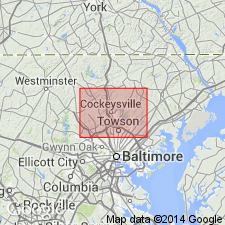
- Usage in publication:
-
- Cockeysville formation
- Modifications:
-
- Revised
- Overview
- AAPG geologic province:
-
- Piedmont-Blue Ridge province
Summary:
Cockeysville, referred to in this report as formation, is a sequence of intricately folded carbonate-rich metasedimentary rocks about 750 ft thick and of pre-Silurian age. Formation lies near base of Glenarm series, which mantles five elongated domes of Precambrian(?) basement gneiss at eastern edge of Piedmont province. Overlies Setters formation; underlies Wissahickon formation.
Source: GNU records (USGS DDS-6; Reston GNULEX).

- Usage in publication:
-
- Cockeysville marble
- Modifications:
-
- Age modified
- AAPG geologic province:
-
- Piedmont-Blue Ridge province
Summary:
Cockeysville shown on State map as probably early Paleozoic in age.
Source: GNU records (USGS DDS-6; Reston GNULEX).
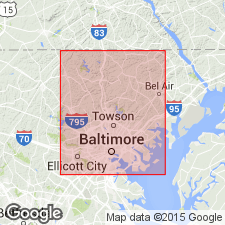
- Usage in publication:
-
- Cockeysville Marble
- Modifications:
-
- Revised
- AAPG geologic province:
-
- Piedmont-Blue Ridge province
Summary:
The Glenarm is raised in rank to Supergroup in this report and includes the Setters Formation, the Cockeysville Marble, and the Wissahickon Group, also raised in rank. Distribution of rock types within the Cockeysville reflects an unusual complexity, including facies changes, unconformities, and deformation. Author has erected a six-fold stratigraphy for the Cockeysville consisting of five unnamed members and one lens to accommodate the variety of rock types. These are the layered marble member (0 to 200 m), the massive metadolostone member (0 to 400 m), the layered metadolostone member (0 to 1.4 km), the massive metalimestone member (0 to 450 m), which includes the calc-gneiss lens (0 to 225 m), and the phlogopitic metalimestone member (0 to 300 m). Each member is described in detail. Thickness of the Cockeysville overall varies from 0 to 1.4 km, the range of the layered metadolostone. The relative ages of these units are uncertain. Unit as a whole is mapped as Cambrian to Ordovician(?).
Source: GNU records (USGS DDS-6; Reston GNULEX).
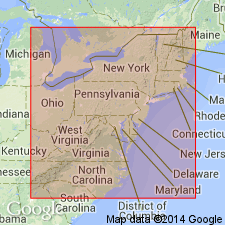
- Usage in publication:
-
- Cockeysville Marble*
- Modifications:
-
- Revised
- AAPG geologic province:
-
- Piedmont-Blue Ridge province
Summary:
Following Drake (1986, Geological Society of America, Abstracts with Programs, v. 17, no. 7, p. 566), Glenarm Group consists of Setters Formation, Cockeysville Marble, and Loch Raven Schist. The Oella Formation is part of an overlying thrust stack and not part of the Glenarm. Glenarm Group was deposited over Baltimore Gneiss.
Source: GNU records (USGS DDS-6; Reston GNULEX).
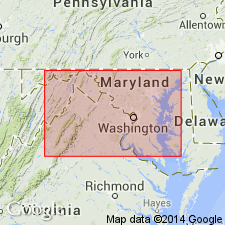
- Usage in publication:
-
- Cockeysville Marble*
- Modifications:
-
- Age modified
- AAPG geologic province:
-
- Piedmont-Blue Ridge province
Summary:
Age of the Cockeysville Marble is changed to Cambrian and Ordovician(?), following the usage of Crowley, W.P. (1976, The geology of the crystalline rocks near Baltimore and its bearing on the evolution of the eastern Maryland Piedmont: Maryland Geological Survey Report of Investigations 27, 40 p.)
Source: GNU records (USGS DDS-6; Reston GNULEX).
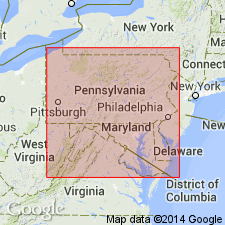
- Usage in publication:
-
- Cockeysville Marble
- Modifications:
-
- Revised
- AAPG geologic province:
-
- Piedmont-Blue Ridge province
Summary:
Use of terms Wissahickon Group and Glenarm Supergroup discontinued in MD. Baltimore terrane cover sequence is described using individual formation names.
Source: GNU records (USGS DDS-6; Reston GNULEX).
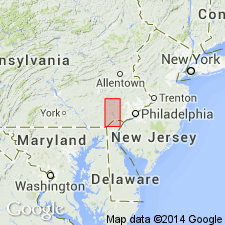
- Usage in publication:
-
- Cockeysville Marble
- Modifications:
-
- Overview
- AAPG geologic province:
-
- Piedmont-Blue Ridge province
Summary:
Detailed analysis of field relations at five locations near Doe Run reveal that Wissahickon Group consistently lies above, and with angular contact upon, an overturned stratigraphic sequence of Grenville-aged gneiss above Late Proterozoic to early Paleozoic Setters Formation and Cockeysville Marble, all three assigned here to the Brandywine terrane. Evidence supports the theory that the Wissahickon Group was emplaced after peak metamorphism. Identification of the Doe Run thrust fault at the base of the Wissahickon contradicts the previous assumption of stratigraphic continuity throughout the Glenarm Supergroup of southeastern PA and DE.
Source: GNU records (USGS DDS-6; Reston GNULEX).

- Usage in publication:
-
- Cockeysville Marble*
- Modifications:
-
- Revised
- AAPG geologic province:
-
- Piedmont-Blue Ridge province
Summary:
Loch Raven Schist is here removed from Glenarm Group because current work shows that Loch Raven Schist is thrust over either Cockeysville Marble, Setters Formation, Baltimore Gneiss, or Laurel Formation. The Glenarm sequence consisting of schist of the Setters, quartzite of the Setters, and Cockeysville Marble is exactly the same as that of Pine Mountain Group in AL, which consists of Hollis Quartzite, Manchester Schist, and Chewacla Marble (Higgins and others, 1988), the cover sequence on Laurentian basement in Pine Mountain window.
Source: GNU records (USGS DDS-6; Reston GNULEX).
For more information, please contact Nancy Stamm, Geologic Names Committee Secretary.
Asterisk (*) indicates published by U.S. Geological Survey authors.
"No current usage" (†) implies that a name has been abandoned or has fallen into disuse. Former usage and, if known, replacement name given in parentheses ( ).
Slash (/) indicates name conflicts with nomenclatural guidelines (CSN, 1933; ACSN, 1961, 1970; NACSN, 1983, 2005, 2021). May be explained within brackets ([ ]).

